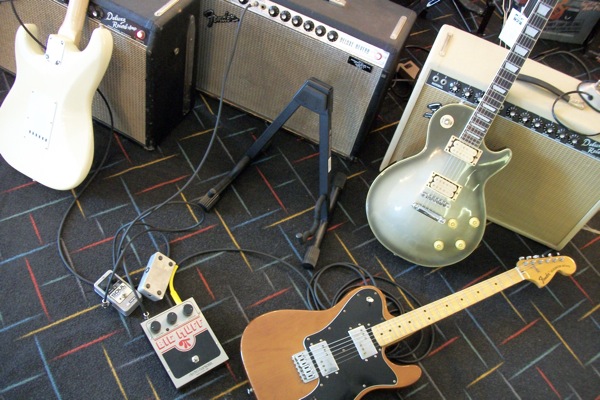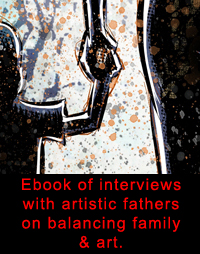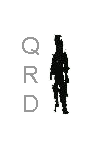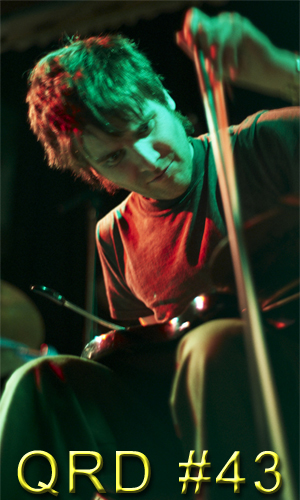
August 2010
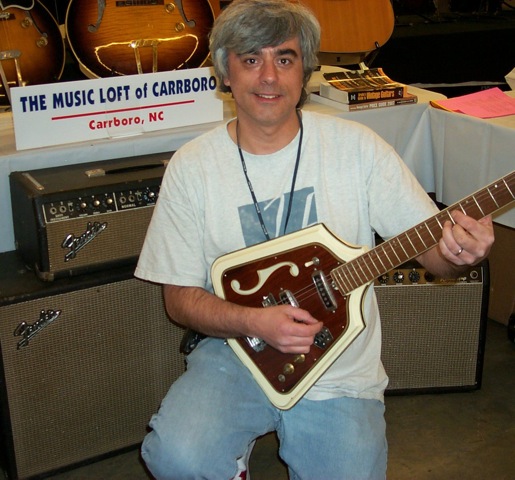
Name: Jim Dennis
Bands: Random FX, Purr Factory, Monomania
Listen to "Atmospheric Disturbance"
QRD – What was your first guitar & what happened to it?
Jim – My first guitar was a $30 piece of junk that I got for my 11th birthday. I hung it on my wall & whenever someone asked me what I wanted for my birthday/Christmas I would tell them money because I was saving up for a REAL guitar. A year later I bought a Madeira dreadnought & six months after that I took the wall hanging guitar outside & smashed it Pete Townsend style.
QRD – What’s your typical set-up from guitar to effects to amplifier?
Jim – I have different setups depending who I am playing with or what I am doing. For my “spacey” jams sessions I use a 1997 Fender Strat that I installed a Roland GK pickup system in. That goes to a Roland VG-8 for guitar sounds & also a Roland GR-20 for synth sounds. The stereo output then goes into a Line 6 Delay Modeler pedal. No amp used, just straight into the mixing console from there.
QRD – What’s the most important part of your rig: guitar, amplifier, or effects?
Jim – The guitar. If I don’t feel comfortable with my instrument, I can’t concentrate on the music to be made.
QRD – What’s your main amplifier & why?
Jim – I have a Teisco Del Ray Checkmate 25. Basically it is a Fender Princeton type head (all tube with reverb & tremolo & about 12 watts) with an open back speaker cabinet with a single 15” speaker. Electric guitars sound great through 15s. Ever heard Led Zeppelin I? The Teisco sounds full & even on lower volume & breaks up perfectly when you get her over 6 on the volume knob. The higher the volume the more breakup & tube distortion.
QRD – What’s your main guitar & what are the features that make it such?
Jim – I have a Fender Made in Japan ‘60s Strat made in the 80s that is Daphne Blue & 100% stock. The only thing I have changed is the strings. It’s the perfect example of a Stratocaster with a nice slab rosewood fingerboard. Everyone that picks it up gives me this surprised look about 6 seconds after they start playing it. I paid $180 in 1990 for it.
QRD – If you had a signature guitar, what would it look like & what would some of its features be?
Jim – Fender Strat with a small headstock, rosewood fingerboard, & nickel hardware. Single coil regular pickups, 13 pin Midi pickup, & piezo kinda acoustic pickup. Locking tuners with a LSR roller nut & a two pivot point bridge. It would have to be blue & weigh less than 6 pounds.
QRD – If you had a signature pedal, what would it be & what would some of its features be?
Jim – It must have a signal to noise ratio of 130db, run for ten years on one 9 volt battery, be able to run in mono or stereo, handle 4 types of connectors & 6 different signal levels (line, instrument, lo z, etc.) & be able to handle a thirty foot drop & a thirty minute fire & keep working. It would sound like you are playing through 10 different amps setup all over the room you are in & it would bathe you in sound.
QRD – How many guitars do you own?
Jim – I have about 26 instruments with strings. Most of them are guitars, but I also own a mandolin, bowed psaltry, & an eight stringed Kenyan Harp.
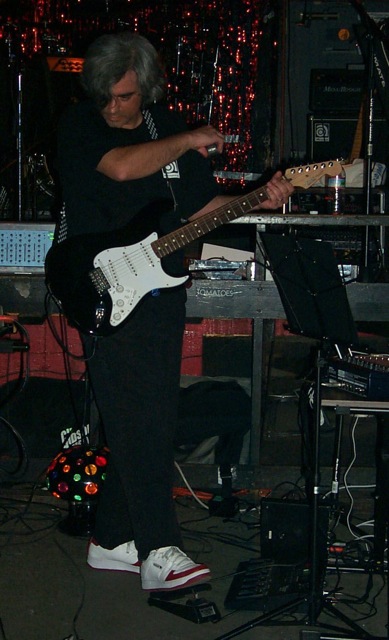
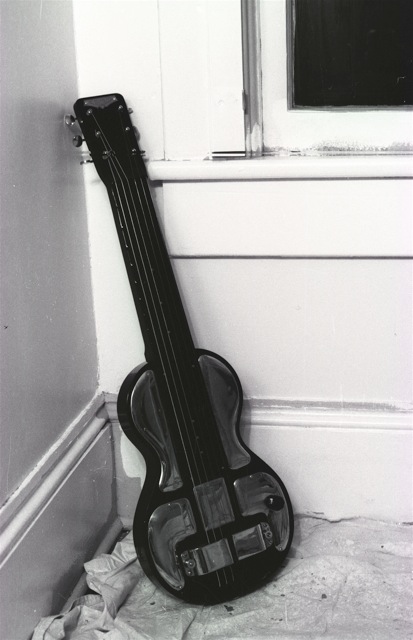
Jim – I use a bedroom in my house as a music room & have several “String Swing” wall hangers for some “go to” instruments. I also have two stands that hold 5 guitars each. Half of my guitars are in cases in the closet.
QRD – What do you wish guitar cases had that they usually don’t?
Jim – A little pocket that would hold the little paper label from a set of guitar strings. That way you could put the label in the pocket when you change the strings. If you put the guitar away or own several instruments you would always know what strings (brand & gauge) are on it.
QRD – What features do you look for when buying a guitar?
Jim – How it sounds acoustically when you play chords in the first position. Does it ring out? Are all the strings balanced in tone & volume? That’s the first thing with an electric or acoustic guitar. The sound of the instrument. Then I check neck profile & radius. Is it going to be comfortable to play for an entire evening? Next I look at craftsmanship & tolerances starting at the bottom strap button & going all the way up to the tip of the headstock. Hardware I check last. As far as playability goes, the guitar can have some leeway, as long things aren’t too far out of spec. I always set up my instruments, so as long as it can be adjusted I don’t worry if it doesn’t feel exactly perfect. It can be somewhat perfect.
QRD – How much do you think a good guitar should cost?
Jim – $400. I think great guitars could cost more than $400.
QRD – Do you upgrade & customize your guitars or just stick with what you get?
Jim – When I bought my ‘97 Strat mentioned earlier, the guy told me he would sell me the guitar, but he wanted to keep the pickups. I clipped the two wires at the output jack, unscrewed the pickguard & handed him the whole assembly - pickups, selector switch, pots & all. Those items are easy & fun to change & replace & experiment with.
QRD – How thoroughly do you research or test a piece of equipment before buying it?
Jim – I generally know what I’m getting into if I am putting out cash for gear. I like to find out how it holds up from other players before I buy most things. Sometimes when I know a particular product line well I can rely on my past experience also.
QRD – Do you change your rig around often?
Jim – No, but I use three different rigs right now for different purposes. I have the “main rig” I detailed earlier that I schlep around to my friends’ studios plus a different one that stays plugged in at home for recording. I have a rig with the Checkmate 25 amp plus some pedals for traditional band situations. I also play acoustic guitar with some friends about once a month.
QRD – Are you after one particular guitar tone & locking into it, or do you like to change your tone around a lot?
Jim – I enjoy playing different types & styles of music & that requires different tones. I also like to be able to pull up a sound that blends well with whatever happens to be thrust upon me when improvising with others.
QRD – What are some guitars, amps, & pedals you particularly lust after?
Jim – I would love to own an Eventide Harmonizer. As far as guitars go there are a few I could stand to own. A nice old Gibson Firebird with mini humbuckers, Les Paul gold top with P-90s, Greco Iceman, Danelectro doubleneck, Chapman Stick, Harp Guitar.... I could go on.
QRD – What do you think are some important features to be on a person’s first guitar that aren’t always there?
Jim – Really good tuning machines. It’s hard enough to learn without the instrument fighting you just to tune it.
QRD – What have been the best & worst guitar related purchases you’ve made?
Jim – I bought a Boss TU-6 Tuner 25 years ago & it still works great. I have set the intonation of many instruments with it & even tuned a few autoharps as well! The worst is when you buy something that turns out to have been misrepresented by the company or the seller or the instrument itself.
QRD – What are some effect, amp, & guitar brands you particularly like or dis-like & why?
Jim – I think Electro-Harmonix makes the most fun out there today. Crazy pedals. Weird stuff. Would you name a product “Flanger Hoax” & expect to sell a bunch? I also like the fact that they have over two dozen pedals for less than $100 & even the Big Muff is true bypass. As far as amps go, did anyone else notice that for 25 years the tone controls on Marshall 50 watt & 100 watt heads didn’t do anything? Most guys would turn them up to ten & leave them there. One of my big personal guitar heroes is Adrain Belew & he has his own model of Parker guitar. As many times as I have picked up a Parker I have never found one that did it for me. They have great craftsmanship & materials, but they always seemed a bit sterile to me.
QRD – What’s the first thing you play when you pick up a guitar?
Jim – I play a G major chord first.
QRD – How old were you when you started playing guitar?
Jim – Twelve.
QRD – At what age do you think you leveled up to your best guitar playing?
Jim – I think that next year will be my best. Until the year after that....
QRD – Why do you think a guitar fits you more so than other instruments?
Jim – It seems like a natural & ergonomical way to make music. It keeps your mouth free to sing & your legs free to do whatever legs do. Both hands have to work together to play a chord or note, but the fretting hand has to do its job a fraction of a second before the strumming hand for it to work. Maybe the guitar is just loud & portable.
QRD – Do you think guitar should be people’s first instrument as often as it is?
Jim – Yes. Both hands work together (unlike piano) & you have frets (unlike violin).
QRD – Do you see your guitar as your ally or adversary in making music?
Jim – We both fight for the same team.
QRD – Who are the guitarists that most influenced your playing & sound?
Jim – I am an amalgamation of everything that was on FM radio in the 1970s when I was growing up & that includes much stuff from the sixties too. Some of my heroes are Jeff Beck, Adrian Belew, Chet Atkins, Bill Frisell, Frank Zappa & Pat Metheny.
QRD – Do you think people anthropomorphizing their guitars is natural or silly (e.g. naming their guitar)?
Jim – I don’t name my instruments, but I do consider them to be my friends. When people ask me what they should look for in a guitar, I tell them to find one that seems like a friend. My amp tech has a 1964 Jazz bass named Francine & that seems to make sense to me....
QRD – What’s the most physical damage you’ve done to a guitar & how did you do it?
Jim – I burned an orange guitar. I did it with lighter fluid & a lighter. It was fun.
QRD – What do you do to practice other than simply playing?
Jim – I make up songs in different styles or try to play songs I have never played before. It’s good for keeping your mind limber as well as your fingers. I should do it more often.
QRD – How many hours a week do you play guitar & how many hours would you like to?
Jim – Right now I play about 3 hours a week of real playing time. I would love to play over an hour a day.
QRD – What type of pick do you use & why?
Jim – Fender 351 medium because I have used it forever & it’s ubiquitous. If I forget to bring a pick to a studio there WILL be a Fender medium laying around.
QRD – What gauge strings do you use & why?
Jim – 10 - 46 regular light gauge. Smaller strings don’t give guitars enough output & bigger ones make my hands tired too quickly.
QRD – How often do you change strings?
Jim – I am very lucky to have been born with the perfect skin ph for guitar strings. If I don’t sweat on them I can keep them going for months on end.
QRD – How often do you break strings?
Jim – Only once a decade or so.
QRD – Which do you feel is more proficient, your strumming hand or fretting hand & how does that effect your style?
Jim – I think they are pretty evenly matched, but sometimes they don’t work together as well as they should....
QRD – Do you set-up your guitar yourself or send it to a guitar tech (or not set it up at all) & why?
Jim – I set-up my own guitars & also set them up for other guitarist. I have also taught several people to set-up guitars.
QRD – What tunings do you use & why?
Jim – I keep my guitars in standard tuning. I also play baritone guitar which is down a fourth B - E - A - D - F# - B & I keep my lapsteel in DADGAD.
QRD – Do you prefer tablature, sheet music, or some other notation system for writing down your own ideas?
Jim – I generally will record my musical ideas so I don’t loose them. I find it easier to get the “feel” of the piece by listening back then decoding rambling notes on paper.
QRD – How high do you hold your guitar when playing (strap length)?
Jim – The strings are just above my waist. Most importantly, I try to keep my left wrist straight when I play.
QRD – What’s a bad habit in your playing you wish you could break?
Jim – Moving my fingers more than necessary to accomplish the next task. Have you ever watched someone that has put lots of effort into that? When they play it looks as if their fingers don’t really move enough to do what you hear.
QRD – Playing what other instrument do you think can most help someone‚s guitar playing?
Jim – Hard question. I am going with percussion for $50 Mr. Trebek. I think that rhythm & dynamics are the two areas that should be higher on the agenda & percussion is a great way to demonstrate & concentrate on not playing notes & learn to put them at the front of your practice regimen.
QRD – What’s a type of guitar playing you wish you could do that you can‚t?
Jim – Can you hear a Thelonius Monk tune on one guitar with a walking bass line, chords & a melody? That’s not me. I would have to quit my job & play ten hours a day just to find out if I could learn how to do that.
QRD – What’s a guitar goal you’ve never accomplished?
Jim – Record a Guitar Army album. Imagine standing in front of an orchestra of 40 people playing. Now imagine all 40 people are me & I’m playing guitars & the music may sound similar... or not.
QRD – What’s the last guitar trick you learned?
Jim – Re-amping. I record a track & then send it back through a chain of guitar processing (real or software plug ins) to give it a completely different sound. Let’s say I’m tracking a rhythm guitar by playing my DeArmond through an Adrenalin (amp modeling & cab simulator with effects) & recording this as a stereo track. I take a dry signal of the guitar (pre-Adrenalin) & record it as a mono track. Then, this mono track looks just like a guitar to whatever you plug it into. So I can replace the track with too much reverb with a better blend or no reverb. Or turn down the gain for a warmer distortion. Just what a guitar player needs, more options....
QRD – What’s your favorite guitar gadget (ebow, capo, slide, string cutter, etc)?
Jim – Ebow. So favorite I don’t pull it out for months at a time for fear of overusing it & becoming “that Ebow Guy.” I just love using it with a guitar synth & a bit of echo. Yummy.
QRD – What’s a guitar technique you‚d like to master, but haven‚t?
Jim – Western swing or gypsy jazz style of playing passing chords. That’s the one thing that would make me take lessons at my advanced age.
QRD – Did you ever take guitar lessons & if so, what did you learn from them?
Jim – Speaking of lessons.... No. When I was a kid we lived out in the country so there was never a real guitar teacher. When I bought my guitar at twelve I also purchased a chord book, pitch pipe to tune, & two books of songs that I was familiar with. I figured I know how the songs should sound & I can look up the fingering for the right chords to play, so all I have to do is teach myself how to strum. That was my teenage logic.
QRD – What would you teach someone in a guitar lesson that you don’t think they would generally get from a guitar teacher?
Jim – How much dynamics can add drama & style to music.
QRD – What’s something someone would have to do to emulate your style?
Jim – Use a slow vibrato at the end of a bend.
QRD – What’s your take on tremolo systems?
Jim – I think they are great for folks who are mechanically inclined. If you want something to fiddle with, get a guitar with a trem. If the thought of changing your strings makes you go a bit green, you should probably work on your finger bending technique. I’m being a bit dramatic. If you go there, you should be ready to learn how it works so you can troubleshoot things like tuning problems & pickup height.
QRD – How often do you adjust your tone knob?
Jim – Never. Guitars have tone knobs?
QRD – What do you see as the difference between lead guitar & rhythm guitar players?
Jim – I really like Jimi Hendrix as a guitarist as well as a musician. When I listen to him play, what really blows me away is his rhythm work with all the passing notes & phrases. How about the untitled instrumental from Woodstock? In other words, I think all guitarists should be rhythm guitar players first so they will know how to be great lead guitar players when it’s time for that. In the strictest sense of the words, one could argue that the rhythm guitar plays throughout a 3 minute pop song & the lead gets about 4 bars. I think you have to be a good guitar player to play all three minutes well.
QRD – If a band has good guitar work, can you ignore the rest of the band not being good?
Jim – If ignore is not a black & white word, but has many shades of grey....
QRD – What famous musician‚s guitar would you like to own & why?
Jim – Frank Zappa. I hope that he will be remembered as a great American composer & a wailing modal lead guitar player.
QRD – Who do you think is currently the most innovative guitar player & why?
Jim – Hard question for an old guy like me. I don’t really live on the cutting edge these days but Adrain Legg comes to mind for oddly tuned 12 strings & finger picking. Pat Metheny playing with mechanical machines is pretty edgy....
QRD – Where can people hear your best guitar work?
Jim – I’m not really good at getting my stuff out there, but go back to the interview with Ted Johnson. I am on most of the tracks he had up at the Internet Archive. That’s a couple of hours.
QRD – Anything else?
Jim – I like the fact that you can use many types of pickups & hardware, frets & tunings & shapes & sizes for a guitar & under it all is a piece of wood with it’s individual grain & density. The wood is part of the “intangibles” that make every instrument different & some even more like people.
